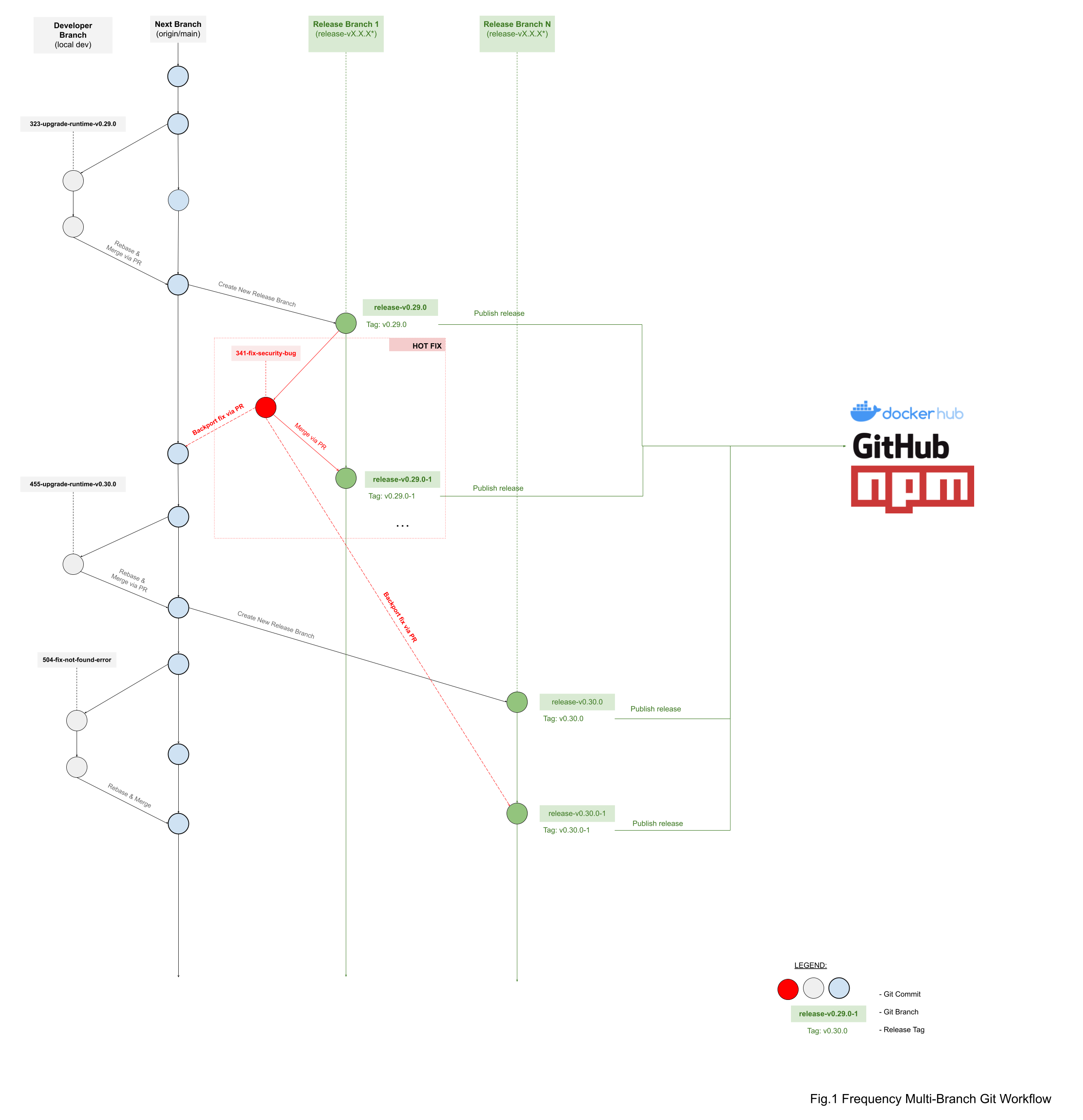-
Notifications
You must be signed in to change notification settings - Fork 20
Frequency Git Workflow

Source Diagram: https://docs.google.com/drawings/d/1GyvodIcZ3AfrfmpgK465N369Lu-F41Ni-__Gvk4p6iQ
This page describes Git branching workflow employed by the Frequency team during development and release cycles. This workflow has 4 types of branches:
| Number | Branch Name | Type | Branch Pattern | Purpose |
|---|---|---|---|---|
| 1 | Developer Branch | Short-Lived | [issue#]-[brief-descriptive-name] |
a.k.a "feature branch", used to develop new features and make other changes for the upcoming releases. |
| 2 | Release Branch | Long-Lived | release-v[x.x.x*] |
Frequency release tied to the specific Polkadot release version, etc., e.g. release-v0.9.29, release-v0.9.30, release-v0.9.30-1, etc. |
| 3 | Next Branch | Long-Lived | origin/main |
Represents the next version under development, i.e. a release candidate. |
| 4 | Hot Fix Branch | Short-Lived | [issue#]-[brief-descriptive-name] |
These hot fix branches are necessary to act immediately upon an undesired status of one of the current releases (Rococo and/or Mainnet). |
Once a long-lived branch is created, it can stay in the repo forever. In other words, there is no time limitation on the lifecycle of such branch.
To work on something new:
- Create a new developer branch off
mainand give it a descriptive name starting with the story number (ie:504-retire-msa-id,,323-upgrade-runtime-v0.29.0, etc.) if there is a GitHub story associated with this change. Direct commits tomain` are not allowed. - Commit to that branch locally and regularly push your work to the same named branch on the server.
- Run tests locally.
- When you need feedback or help, or you think the branch is ready for merging, open a pull request. This will trigger "Verify PR" CI workflow which will execute multiple checks on the code changes in the PR.
- If CI fails, address reported issues and push a new commit to remote. This will trigger a new "Verify PR" workflow run. Repeat this step until all jobs in CI are passing successfully.
- After someone else has reviewed and signed off on the feature, you can merge your PR into
main.
When code in main is ready to be released a new release branch must be created if the changes contain a runtime upgrade. This release branch needs to have a version in its name tied to the official Polkadot release.
Examples of the release branches:
-
release-v0.29.0- release branch which was upgraded to Polkadotv0.29.0runtime. -
release-v0.30.0- release branch which was upgraded to Polkadotv0.30.0runtime.
Pushing commits to a release branch will not automatically publish a new release. To trigger a release, a deployer needs to tag a given commit with the vx.x.x* release tag and push it to the remote. This will trigger the "release" CI workflow.
Examples of the release tags:
-
v0.29.0-rc1- release candidate corresponding to Polkadotv0.29.0runtime -
v0.29.0- full release corresponding to Polkadotv0.29.0runtime -
v0.29.0-1- additional change 1 to the existingv0.29.0Frequency full release -
v0.29.0-2- additional change 2 to the existingv0.29.0Frequency full release -
v0.30.0- corresponds to Polkadot full releasev0.30.0
Basically, the release process consists of these steps:
- Create a
v*release tag and push it to remote. - Wait for the “Release” CI workflow to finish and create a new GitHub release with artifacts.
- Edit GitHub release page as needed.
When a release is triggered on a given release branch, all artifacts for all networks will be built and published. This gives the node owner a flexible choice to use any artifact from any published release version.
The deployer is responsible for creating a proper versioned release tag. No duplicate tags are allowed.
Hot fixes are used to quickly patch production releases. These fixes can be made directly to a release branch via a PR. The developer is responsible for porting hot fixes back to main and whatever other release branch those changes may be applicable to.